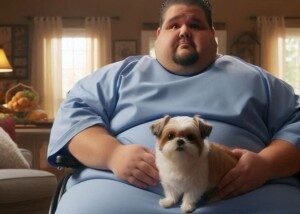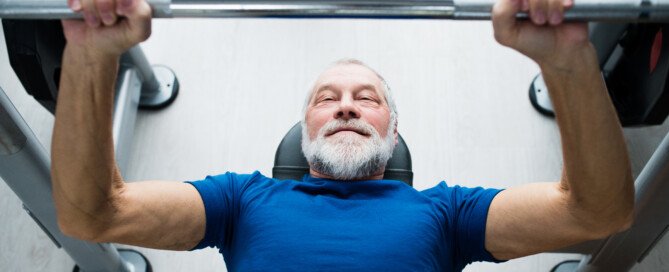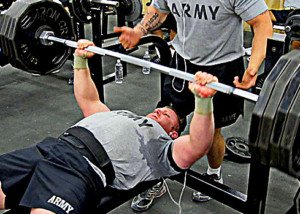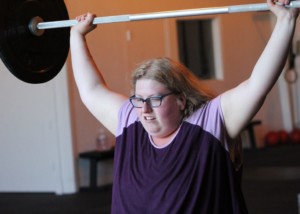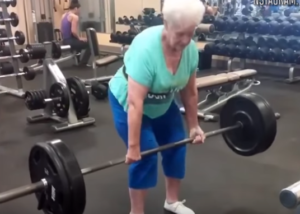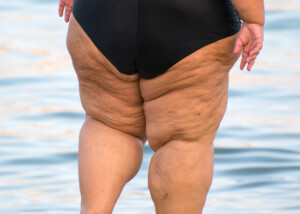Lifting Weights, Even Heavy, Won’t Stunt Teen Boy’s Growth

Why is it that so many teen boys worry that lifting weights will stunt their growth, but are less worried about the reality that SMOKING will stunt their growth?
Are you a teen boy afraid that lifting weights will stunt your growth? Stop Worrying!
Some teen boys on the short side who wish to get stronger muscles will avoid lifting weights due to concern that it will stunt their growth: namely height.
The irony is that these same teen boys will do exercises that don’t involve lifting weights, such as pushups and pull-ups, since they believe that weight workouts will stunt growth.
First of all, when you do those pushups, are you not pushing against your body weight?
You won’t bench press a barbell due to fear of stunting growth, but you’ll gladly do the pushups. But a pushup is an inverted bench press.
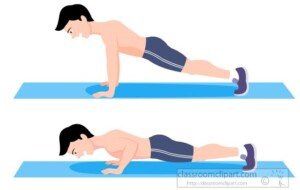
A pushup is a form of weight lifting: You are using chest, shoulder and arm muscles to push against a weight: your body.
In the case of a bench press, you are using chest, shoulder and arm muscles to push against a weight: the barbell! It’s the exact same principle. The only difference is that your body is flipped!
A teen boy concerned about weight lifting stunting his growth might avoid lat pull-downs, but will gladly do pull-ups (and chin-ups).
But a pull-up is the same as a lat pull-down. In a lat pull-over, you are grabbing something above your head (the bar) and pulling it down.
In a pull-up, you are grabbing something above your head and pulling downward to lift your body upward.
The only difference is that the result of the pull in a pull-up is that your BODY moves, rather than the BAR moving.
I once read a blog of a teen boy who stood 5-6 and feared that lifting weights would stunt his growth, so he described his routine that did not involve any dumbbells, barbells or machines.
The routine included seated dips. If you clicked on this article, you probably know what seated dips are:
You get between two benches, prop feet on one, hands on the other, and lower yourself down and push back up to work the back of the arms.
Though no dumbbells or barbells are used, this is every bit as much of a weight lifting exercise as using a barbell: You are pushing against YOUR own weight.
Where did the idea ever arise that lifting weights can stunt a teen boy’s growth?
Perhaps it’s because it’s common to see in gyms short but very muscled men. I have another explanation:
Short teens and short young men, feeling self-conscious about their height, take up bodybuilding to compensate.
In an attempt to compensate for lack of height, these teen boys and young men go all-out with their workouts, and hence, develop impressive physiques.
Tall men, not feeling insecure or a need to compensate, may not throw themselves as much into working out, and hence, why you don’t see as many tall men rippling with slabs of muscle.
Intense strength training will increase production of human growth hormone (HGH). This has been proven by science; it is a medical fact.
A teen boy who seriously trains with dumbbells, barbells and machines will spur production of HGH.
However, this does not mean that a 5-4 teen boy will sprout to 5-11 in two years. The greatest determinant of his final height will be his parents’ height.
But because intense strength training raises production of HGH, teen boys can be very assured that lifting weights will never stunt growth.
The extra release of HGH will maximize the height that your genetic blueprint has in store for you.
 Lorra Garrick is a former personal trainer certified through the American Council on Exercise. At Bally Total Fitness she trained women and men of all ages for fat loss, muscle building, fitness and improved health.
Lorra Garrick is a former personal trainer certified through the American Council on Exercise. At Bally Total Fitness she trained women and men of all ages for fat loss, muscle building, fitness and improved health.
How Many Laryngeal Cancer Patients Have No Risk Factors?
Though laryngeal cancer is strongly linked to several risk factors, a small percentage of patients have no known risk factors. (more…)
How Many Laryngeal Cancer Patients Are Nonsmokers?

Nonsmokers can get laryngeal cancer, but can it be reassuring to know what percentage of laryngeal cancer patients don’t smoke? (more…)
How to Remove Porcupine Quills from a Dog’s Fur

Has your dog’s fur been embedded with countless porcupine quills? Here’s a technique that will get out every last porcupine quill from your dog’s coat. (more…)
How to Make a Dog Pass the Plastic Bag It Ate

Did your dog just swallow a plastic bag?
Don’t panic yet; here’s a simple way to make your dog pass the plastic bag right out of its system.
This happened to my sister’s dog, a black lab.
This black lab made the poor life choice of consuming a plastic shopping bag that must have come in contact with food stuff.
Sometimes things happen with dogs too quickly for their owners to intercept; before she knew it, my sister’s lab had eaten the plastic bag.
Once the bag had been consumed and was going through the process of digestion, the only solution was to speed up the process to ensure the indigestible item came out the other side without causing serious and potentially fatal bowel obstructions.
I’m not recommending you bypass taking your pet to an emergency vet clinic, but what if that’s not an immediate option?
What if this occurs after hours and there’s no nearby vet clinic open?
What if this occurs while there’s a snowstorm?
What if your car doesn’t start or is not available?
Oil Based Solution to Dog Eating a Plastic Bag

A tablespoon of vegetable or fish oil, mixed in with the dog’s food, assisted in this process.
On the morning the evidence of her wrongdoing arrived, she was struggling and straining in her morning movement.
The poor black lab made every attempt to move the plastic bag from her backside, but she required assistance to get it out.
Only a portion of the bag would come out, regardless of her straining.
After minutes of desperate trying, my sister assisted the dog in pulling out a significant portion of the plastic bag, but it wasn’t the complete item.
The remainder of the plastic shopping bag required ongoing use of vegetable or fish oil to assist the lab in passing the foreign items from her bowel.
As my sister’s husband suggested at the time, “Easy in, easy out!” my sister moved the item through the dog’s bowels as quickly as possible with the help of the oil’s lubricating effect.
So in the absence of a veterinarian’s help, you now have a potentially feasible solution that may help your dog pass a plastic bag that it just ate.
Nevertheless, don’t wait for this event to occur before you ask your veterinarian about this method.
Get a vet’s opinion first, and then do whatever it takes to keep plastic bags out of your dog’s mouth’s reach.
 Lorra Garrick has been covering medical, fitness and cybersecurity topics for many years, having written thousands of articles for print magazines and websites, including as a ghostwriter. She’s also a former ACE-certified personal trainer.
Lorra Garrick has been covering medical, fitness and cybersecurity topics for many years, having written thousands of articles for print magazines and websites, including as a ghostwriter. She’s also a former ACE-certified personal trainer.
Should Elderly People Bench Press?
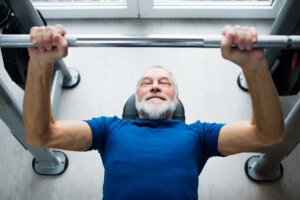
Why do so few elderly people at the gym bench press?
More appalling is that so few personal trainers have their elderly clients bench pressing.
The bench press is one of the easiest exercises to perform. Geez, the person gets to lie down, for starters. Older people with bad knees will welcome this. (more…)
Why Women Think It’s Polite to Accept Rides from Strangers

It’s actually true that some women will accept a ride from a stranger because they think it’s the polite thing to do, that it’d be rude to decline. (more…)
What Does the Hunger of Prader-Willi Syndrome Feel Like?

“Never feeling full” is a poor description of the hunger of Prader-Willi syndrome.
We’ve all been hungry, but not hungry enough to eat dog food or cardboard. (more…)
Why Don’t We See More Plus-Size Women Doing Deadlifts?

When’s the last time you saw a plus size woman doing deadlifts?
I don’t mean baby deadlifts with a 40-pound short barbell, but hammering it out at the “cage”? (more…)
Why Don’t Most Grown Abused Kids Beat Up Their Parents?















